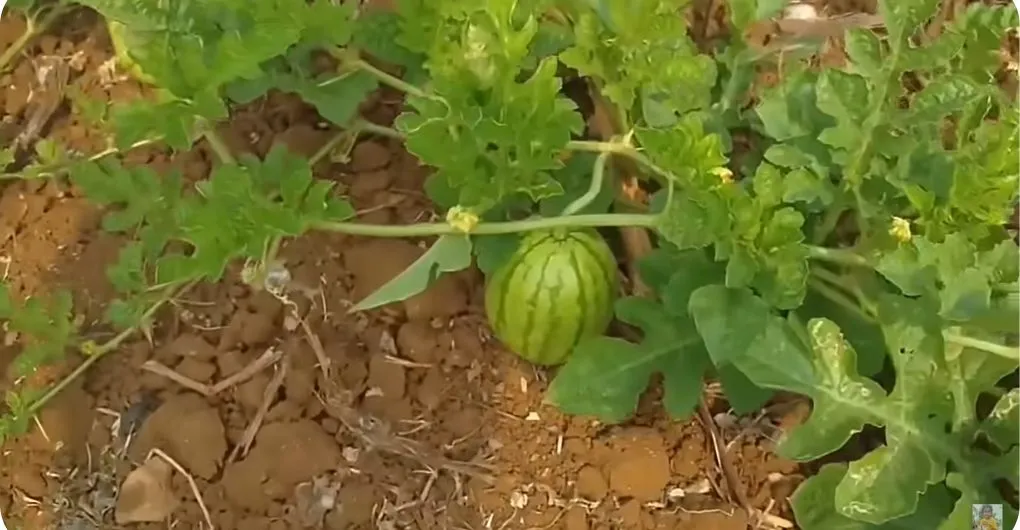It might seem like a silly statement, but it’s not uncommon for people to question the myth do watermelons grow on trees. The juicy, sweet fruit is often associated with hot summer days and picnics, but where do they actually grow from?
Today I will cover the truth behind the growing process of watermelons, and where they come from.
Do Watermelons Grow On Trees?
No, Watermelons do not grow on trees. Watermelons grow on vines that spread along the ground just like grapes, kiwifruit, passionfruit, etc. The plants produce large, oval, or round fruits that grow on the ground and have a thick rind and juicy, sweet flesh. The idea that watermelons grow on trees is a prevalent one. This misconception may stem from people confusing watermelons with other melons that do indeed grow on vines.
People may also have seen pictures or paintings of watermelons being hung from trees, which led them to believe that it is a frequent practice. Folklore and cultural beliefs in several regions of the world also continue to support the notion that watermelons can grow on trees.
Actually, a type of fruit, watermelons are cultivated on vines and are linked to cucumbers, pumpkins, and squash. Watermelons are produced on the ground as opposed to in trees, unlike these other fruits. They are a hot-season crop that is typically sown in the springtime and collected in the summer.
The watermelon plant is a vigorous, ten-foot-long vine. Its leaves are large, rough, and light green in color, and they shade the fruit as it matures. The fruit can weigh anywhere between a few pounds and over 100 pounds.
However, the “Carolina Cross” produced the 159 kg the heaviest watermelon, breaking the previous record 262 pounds (118.7 kg).
Why Cannot Watermelons Grow on Trees?
Watermelons are a sort of vine plant, not a tree, which explains why they don’t grow on trees. They are members of the same family as cukes, squash, and pumpkins, which is the cucurbit family.
These plants sprout from the ground and produce long and twisty winding vines that can reach up to several meters in length. After that, the vines begin to develop leaves, flowers, and finally fruit.
Trees, on the other hand, are much different from vines. They have a strong trunk and branches that extend upward; the branches have leaves, flowers, and fruit.
A taproot, or a deep root system, is another characteristic of trees that helps sustain and anchor the tree in place. Conversely, vines rely on other plants or structures for support because they lack a taproot.
Watermelons are tough to grow on trees because they have certain growing conditions. For instance, a long growing season and a warm, sunny environment are necessary for watermelons.
The vines may grow up to several meters in length, therefore they also require a lot of area to develop and bear fruit. This is why watermelons are typically grown in fields or gardens, rather than on trees.
How Do Watermelons Grow?
Most people don’t realize that watermelons are not actually grown on trees as they appear to be in cartoons; rather, they start off as vines that sprout yellow flowers. These flowers will then transform into small green fruits if pollinated correctly. Once the melon reaches full size (around 10-20 lbs), it’s ripe for picking.
The ideal location to plant them is somewhere sunny but protected from heavy winds so the melons can grow undisturbed. As far as soil goes, look for something nutrient rich like compost or manure, make sure there are plenty of drainages too!
Although growing watermelons involves some work, the reward makes it all worth it. From planting your seeds to harvesting time, watching a patch of plants turn into delectable treats is truly gratifying. With a little help from Mother Nature, you’ll soon have enough watermelons to share with family and friends alike!
Where does Watermelon Grow?
Since ancient times, watermelons have been grown throughout Africa. Today, watermelons are grown all over the world, with China, Turkey, Iran, and the United States ranking as the top four producers.
Watermelons thrive best in hot, humid weather with lots of sunlight seen in tropical regions. They require a long growing season, which is normally between 80 and 100 days, and flourish on soil that is nutrient-rich and well-drained.
Since watermelons need temperatures between 70 and 95 degrees Fahrenheit for growth, they can be grown everywhere in the world.
In addition to warm climates, watermelons can also be grown in greenhouses or beneath protective coverings. Due to the crop’s protection from pests and illnesses, producers are able to grow the fruit in regions with shorter growing seasons or milder temperatures.
Where does Watermelon grow in the United States?
In the United States, watermelons are frequently grown in states like Florida, Texas, Georgia, and California where the warm climate and long growing season enable a high yield.
These states are also home to some of the biggest watermelon-producing operations in the country because they have a high number of farmers that plant a watermelon on a massive scale.
Where does Watermelon grow in India?
In India, the states of Andhra Pradesh, Tamil Nadu, Karnataka, Uttar Pradesh, and Maharashtra have the largest watermelon-growing areas. These regions are perfect for growing watermelons because they have rich soil, lots of sunlight, and the correct quantity of rain.
Additionally, the farmers in these areas have a wealth of knowledge and experience when it comes to growing fruit, which has increased the quantity and caliber of watermelons. Watermelon has consequently developed into a significant agricultural product in India and now supports the livelihoods of several farmers and rural communities.
Where does Watermelon grow in the United Kingdom?
Southern England, where the environment is sunnier and warmer, as well as coastal areas, where the sea breezes aid to reduce temperatures, are some of the greatest sites in the UK to grow watermelons.
Additionally, some greenhouse farmers can grow watermelons all year long by adopting controlled environment methods.
Where does Watermelon grow in Australia?
In the northern states, such as Queensland and the Northern Territory, watermelons are frequently farmed from November to April.
On the other hand, watermelons are often produced in the milder months of January to April in the southern states of New South Wales and Victoria since the summer heat in these areas can be too extreme for the fruit to flourish.
Regardless of region, Australian farmers use irrigation and the proper soil management techniques to ensure that the watermelons are produced to their fullest potential.
What does a Watermelon plant look like?
Watermelon has large and round leaves, with a distinctive lobed shape and a rich green color. The tendrils that cover the vines aid the plant’s ability to cling to objects and climb in the direction of the sun. Small yellow flowers blossom on the vine throughout the growing season, giving way to the fruit.

The fruit is a sizable, round or oblong berry with a green exterior, vivid red meat, and black seeds that can be easily identified. The rind of the fruit hardens and develops a more prominent pattern of stripes or spots as the fruit ripens, making it simple to recognize from other varieties of melons.
How To Grow Watermelons?
Growing watermelons in your garden or farm can be a fun hobby both for gardeners and common people. What’s more, you can earn and enjoy the sweet taste of watermelons. But you need to take care of couple of steps. er are the following:
- Pick the proper location
To grow effectively, watermelons need full sun exposure, therefore it’s crucial to find a spot in your garden that receives at least 8 to 10 hours of daily direct sunlight. The pH of the soil should range from 6.0 to 6.8, and it should be fertile and well-drained.
Avoid planting watermelons in areas that are prone to flooding, as this can lead to disease and rot.
- Planting Watermelon Seeds Indoor
The optimal time to start watermelons inside is three to four weeks before to the final anticipated date of frost. The seeds will have enough time to germinate and develop into sturdy seedlings before being planted in the garden as a result.
Plant the seeds in the damp soil in peat pots with a high-quality seed-starting mixture. When the seedlings have developed two or three leaves, they are ready to be transplanted.
- Planting Watermelon Seedlings in The Garden
Before planting watermelon seedlings in the garden, it is important to start them indoors or in a greenhouse several weeks before the last frost date in your area. Once the seedlings are strong enough, they can be moved into the garden.
The seedlings must be planted at least three to four feet apart in rows that are six to eight feet apart in a sunny area with well-drained soil. After transplanting, give the seedlings plenty of water and keep the soil evenly moist but not soggy.
- Give enough nutrition and water
Watermelons require a lot of water to flourish, thus it’s crucial to maintain a continually moist soil environment. Use a yard hose or a water spray to water the plants deeply once a week. You may also provide the plants the nutrients they require to flourish by using a slow-release fertilizer.
- Bolster the Watermelon Vines
Watermelon vines can get heavy and lengthy, so it’s crucial to give them support to prevent breakage. To keep the vines off the ground, you can use pegs, a fence, or a trellis. When the fruits are ready, it will also be simpler to pick them as a result.
- Be vigilant for infections and pests
Since several pests and illnesses can affect watermelons, it’s crucial to watch out for any warning indications. Squash bugs, mosaic virus, and powdery mildew are a few typical issues. Take immediate action if you spot any warning indications of trouble to stop the issue from getting worse.
- Harvesting Watermelons
When the watermelon’s belly or underside changes from greenish white to buttery yellow or cream, it is time to harvest it. The dark green-skinned variants exhibit this color change the most dramatically.
A watermelon is also considered to be ripe when its smooth top loses its shine, turns dull, makes a dull thump sound when tapped, and has a sugar spot, a yellow patch on the fruit that has been lying on the ground.
To avoid bruising, it’s important to pick watermelons carefully. Be careful not to damage the vine as you cut the fruit’s stem by about an inch with a sharp knife.
List of 25 Different types of Watermelon
Here is a list of 25 different types of watermelon:
- Sugar Baby
- Crimson Sweet
- Yellow Doll
- Moon & Stars
- Charleston Grey
- Allsweet
- Mickeylee
- Seedless Mini
- King of Hearts
- Jubilee
- Golden Midget
- Orangeglo
- Yellow Watermelon
- Dreamery
- Dulce
- Love
- Super Sweet
- Rio Red
- Sweet Lady
- Florida Sweetheart
- Black Diamond
- Banana
- Starlight
- Sugar Lee
- Yellow King
Other Fruits That Don’t Grow On Trees
Below I have compiled a list of other fruits that don’t grow on trees except watermelon.
- Strawberries
- Blueberries
- Blackberries
- Raspberries
- Cranberries
- Grapes
- Kiwi
- Pineapple
- Watermelon
- Cantaloupe
- Honeydew melon
- Papaya
- Mango
- Passionfruit
- Guava
- Avocado
- Coconut
- Dates
- Pomegranate
- Persimmon
- Quince.
Do Watermelons Grow On Trees? Final Thoughts
So, a one-word answer to your question do watermelons grow on trees? Is a resounding No. I hope that this post has provided some clarification on the common misconception that watermelons grow on trees. You can leave me a comment if you have any additional queries. Thank you!
Each fruit has its growth habit and planting tricks. Read my other article to learn more:






An impressive share! I’ve just forwarded this onto a coworker who was doing a little research on this. And he actually bought me lunch because I stumbled upon it for him… lol. So let me reword this…. Thank YOU for the meal!! But yeah, thanks for spending some time to discuss this topic here on your web site.
Wow, I’m glad my post helped you and your coworker! Thanks for sharing it and glad you enjoyed the discussion. More exciting content coming soon. Stay tuned! 😊